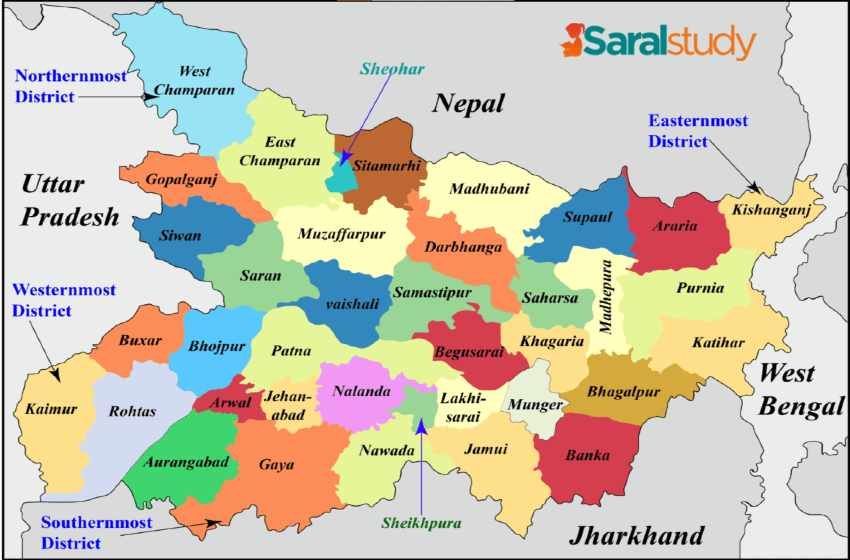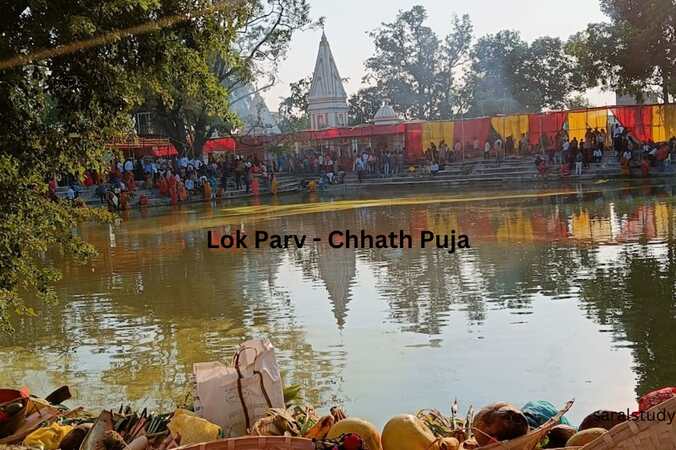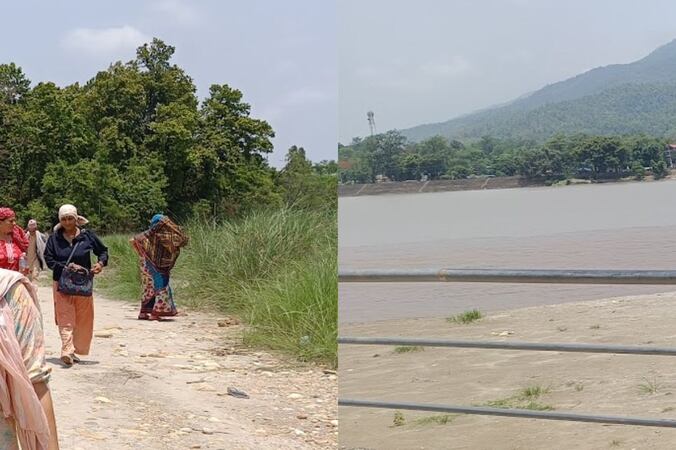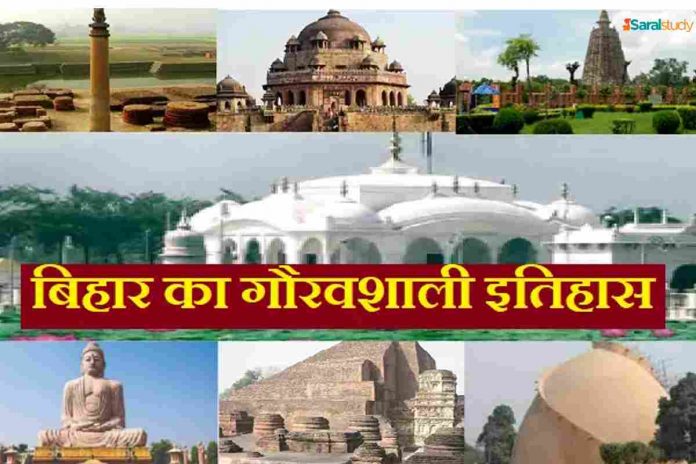Bihar is a state which is one of the old civilizations of India. You won’t find the unmatchable history of Bihar anywhere. It is a prosperous, ageing, marvellous place full of traditions and customs. It is a virtuous land where many kings and scholars were born, such as the tenth Sikh guru Govind Singh, the founder of Buddhism and Jainism, and early great kings. It also provided a prominent place for Hindus and Sikhs in society.
Introduction to Bihar
Bihar is as old as civilisation itself. It is a place of unmatched history that cannot be found anywhere in the world. It is a glorious, colourful and ancient land. Here lived the mythological king Janaka of Videha, Vedic period Rishi Yajnavalkya, Ramayan famed Maharshi Valmiki, Kautilya (Chanakya or Vishnugupta), the author of Arthashastra, the first treatise on modern economics. It is the place where the religious leader, the founders of Jainism (Bhagwan Mahavir), Buddhism (Bhagwan Budhha) and the tenth Sikh Guru Govind Singh were born.
This had been the land where great kings like Chandragupta Maurya, Ashoka and Sher Sah ruled. Here in the land flourished the ancient seats of learning – Nalanda and Vikramshila. `Ahimsa’ was propagated from here and Gandhiji launched his civil disobedience movement against the mighty British. This is the land of great Madhubani paintings, enchanting Sujuni work, Bhagalpuri silks and plenty of delicious Lichies and Mangoes. Bihar has a rich religious history and people from all around the world come to visit this state.
A Brief Info about Bihar
| Country | India |
| Formation | 22-Mar-12 |
| Statehood | 26-Jan-50 |
| Capital | Patna |
| District | 38 administrative districts |
| Body | Government of Bihar |
| Governor | Phagu Chauhan |
| Chief minister | Nitish Kumar |
| Deputy chief minister | Samrat Chaudhary |
| Legislature | Bicameral |
| Parliamentary constituency | 243 seats of Rajya sabha and 40 seats of Lok sabha |
| Mammal | Gaur |
| Bird | Sparrow |
| Flower | Kanchan |
| First Chief Minister | Shri Krishna Sinha alias Shri Krishna Babu (1946–61) |
| Sex Ratio | 918 females per 1000 males |
| Urbanisation Rate | 11.3% (Second lowest in India) |
| Capital | Patna |
| Main Language | Hindi, Bhojpuri, Maithili, Magadhi |
| Best Time To Visit | October To March |
Capital of Bihar – Patna
The capital of Bihar is Patna, whose ancient name was Patliputra. Patna is one of the earliest states of the country, located on the southern coast of Bihar, which has been evidence of the up and downfalls of great kings since its establishment. It is the state’s biggest city. Bihar is considered a religious state by the Sikh community because their tenth Guru, Govind Singh, was born here. Patna produces many farmers all over the country and is also viewed as an agriculture hub.
However, Tourists admire Bihar more because of the birth of the Buddhist and Jainism religion and Bodh Gaya. Patna is famous as it is the hometown of many great scholars and the largest producer of leather in the whole country. The old part of Bihar, founded by Ajatashtru, the king of Magadh, in the 5th century BCE, is later named Patna. In early times, Patna was considered the center of culture and the axis of religion. The certain lag in the economy of Bihar is the education system and the employment opportunities in the state, which result in, people migrating to another state for better earnings and living.
Land of Bihar
The area of Bihar covers around 94,163 km per sq. of geographical land in India. The state is divided into northern and southern Bihar, separated by the holy river Ganga. It is considered that the north of Bihar is surrounded by Himalayan planes while the south of Bihar is by West Bengal. Many rivers, such as Kosi, Mahanadi, and Gandhak, float through the Himalayan range and later merge into the Ganga River. The soil form of both the parts varied from each other as the northern part’s soil is chalky and sandy in texture due to the disaster caused by the earthquake in the Himalayan region.
In contrast, the southern part’s soil is alluvial, which is efficient for agriculture. The climate of Bihar is hot and humid, and densely populated. The forests of Bihar are considered deciduous and cover a large area; the most growing species of Sal is found here.

Ancient History Of Bihar
In ancient times this nation was ruled by great kings like Chandra Gupt Maurya, Khillji Dynasty, Shershah, and Ashoka. It covers a small area of India but shows a significant and incredible impact on its worldwide prosperity. And has a central focal point for its ancient history all over the country. Moreover, this state is surrounded by the country’s holiest river, Ganga. The people of Bihar are classified according to their religion and social caste, as it is one of the biggest populated states in the country. Tourists recognize the state as their prevailing opinion because of its diversified nature, which provides visitors with a wide range of interests. Bihar has occupied a significant position in the prior history of India.
A Glimpse of the Different Dynasty of Bihar
Bihar is considered the most ancient state in the country. It is ruled by great leaders and kings who have provided an excellent infrastructure. It was established by the Magadha king named Brihadratha by extending the role of human advancement, later known as Bihar. It was the main focus centre of great and powerful kings who provided a scope of culture and promotion. ‘Bihar’ originated from ‘Viharas,’ where Buddhist monks rest after their journey. Bihar was ruled by many kings and had a mesmerizing past. Rulers who ruled Bihar earlier are as follows:
- Stone age period (2500-1500 B.C.)
- Mahajanapadas
- Anga kingdom
- Vajji kingdom
- Licchavi kingdom
- Jnatrika clan
- Magadha kingdom
- Brihadrath dynasty
- Haryana dynasty
- Shishunaga dynasty
- Nanda dynasty
Medieval History of Bihar
After the failure of the Gupta dynasty in the 7th and 8th centuries by middle Eastern invaders, Bihar was not the focal point of cultural and political prosperity in India. States were dispersed and ruled by pal kings. Later Bakhtiar khilji captured Bihar, and the Delhi sultanate couldn’t show any power over the state. Bihar worked under the provincial administration, but after the arrival of Mughal emperor Akbar, he captured Bihar and provided better infrastructure and administration. However, as time passed, the Mughals left India, and the attorney of Bihar was given to the Nawab of Bengal.
Modern History of Bihar
During 1757-65, the rule of Britishers in Bengal affected the political life of Bihar. The Jharkhand, Pargana, Santhal and Singhbum remained away from political; parties. At this time, Lord Clive visited Patna in 1765, and the Diwani of Bengal, Bihar, and Orissa was given to the East India Company by the Mughal emperor Shah Alam. However, Bihar people never accepted British rule; there were many revolts against the Britishers like
- The Santhal Pragana revolt of 1781-82
- The how agitation of 1820-21
- Kol agitation 1831-33.
- And most crucial revolt of 1857 which led by Kanwar Singh.
This was the beginning of the national freedom movement in India, and the result of these revolts was the formation of the Brahma-samaj in 1868. Also, the Bihar Times publication was established in 1894 and demanded a separate state. In 1910 Satchidanand Sinha was selected as a member of the central legislative council, and In December 1911, Bihar and Orissa were separated from Bengal. In 1921 Bihar state was first formed, and Orissa was ceded away from Bihar on 1 April 1936 under the Government of India Act 1935 as an independent state. Initially, four provinces and 17 districts were further changed to 5 provinces and 33 districts during 1972-73. When the Jharkhand was formed on 14 November 2000, the state again changed its boundaries.
Art and Culture of Bihar
For several centuries Bihar has been recognized all over the world. Art and culture are one of the most recognized things in Bihar. The artistic sense is old but unique. Madhubani art, a unique painting style, is the most famous piece of work and is considered historic. The customs and rituals varied according to the region and religion. Bihar is a traditional place comprising art, culture, food, dance, and many more. Bihar is one of the country’s most cultural and prestigious states, and the accents and traditions are still the same.
The folk dance and songs are the lights of the occasions in Bihar. Every festival and event is celebrated with full of joy. People of different religions live together and maintain peace. The culture is restored with varied food items, arts, etc. The official language of Bihar is Hindi, but the most common languages are Bhojpuri, Maithili, Angika, etc. At the same time, the state’s elite class speaks Urdu, which is considered the second official language. Bihar has a wide range of artistic classifications in the field of art.
The Bastu Kala and palm leaf paintings seem popular in different regions of Bihar, while the wall painting has a different environmental craze. Bihar has the most significant silk production all over the world. People set up small businesses and created art of their own, and some of the most popular handworks are canvas, Manjusha art, embroidery, and bangle making.
During the period of the Pala king, the paintings received high patronage. There are different primary colours, like colours used for the images like red, green, black, and white, and secondary colours like violet, yellow, light rose, red, grey, ETC. the wall paintings were found very famous here. Lauria, Nandangarh, Laurita-Areraj, Rampurba, and Bashadh are renowned arts of the Ashokan period.
Madhubani Painting (The Mithila Painting):
Though the style is very old yet, it came into prominence recent soon. It is a sort of Folk Art to which the womenfolk had contributed much. Initially drawn on walls and later on, on paper, canvas etc. though the paintings do not augur a great style yet, are rich in imagination, feelings and natural colours. Broadly divided into two categories of paintings, Madhubani paintings concentrate on religious themes as well as decorative ones on the walls of the houses. Nature with her full array of flora and fauna works as the background of the paintings.
Madhubani Art further extended to various ‘Alpanas’ locally known as ‘Aripan Art’. These artistic works are done by the womenfolk in hands on the ground either in front of the houses or in the Courtyards with the help of powdered rice, water and colours. The beautiful designs of different dimensions cover men, animals, birds, flowers, trees, fruits, Gods, Goddesses, Lamps and many other items used in Tantrism. The triangular and rectangular ‘Alpanas’ of Girls worshipping Goddess Tulsi, symbolic ones for the general welfare and marriage etc. are distinctive features of the Art.
Lifestyle of Bihar
The Biharis are very orthodox and strictly follow traditional Indian values. The people are staunch believers of the religion they follow and hence worship gods and goddesses. They follow a very simple lifestyle and live every moment of their lives wholeheartedly. Bihar is known for silk, the majority of people are spotted in silk attires.
Prominent Places and Tourist Attractions In Bihar
Bihar is always on top of the list of tourists as it is full of historical places and monuments, and watching these places is worth witnessing. The most famous places in Bihar are:
- Bodh Gaya
- Mahabodhi temple
- Mangla Gauri shrine
- Vishnupad temple
- Chinese temple and monastery
- Royal Bhutan Monastery
- Barabar caves
- Muchalinda lake
- Dungeshwari temple
- Bodhi tree
- Royal Bhutan Monastery
- Thai temple and monastery
- Nalanda
- Munger
- Ucheswarnath
- Pirpahar
- Kharagpur lake
- Sita Kund
- Shri Krishna Vatika
- Goenka shivalaya
- Kali Pahari
- Vaishali
- Padre ki haveli
- Qila house
There are still so many places that need to be mentioned that define the vast diversity. For example, Bihar is famous for its different cultures, and thousands of people come to Bihar every year to enjoy the immense and beautiful view of art and tradition.
Famous Food in Bihar
When we take a comprehensive look at the culture of India, the first thing that blows our minds is food. Indian food is one of the most famous and favourable things worldwide. The spices, dishes, taste, and love of making food cannot be found easily. Every traditional word carries a different story; it is the centre of ancient civilization and the land of varied crops. It has been famous for the most authentic texture of food for almost 2000 years, so the nutrition of Bihar has its divine history. Some of the most famous dishes of Bihar are as follows:
- Litti chokha
- Sattu
- Kadhi Badi
- Chan Chung
- Dal pitha
- Mutton kebabs
- Chicken korma
- Malpua
- Khaja
- Parwal ki mithai
- Makhana kheer
- Laung Latika
- Naivedyam
- Chandrakant
- Kesar peda
- Thekua
Climate of Bihar
Bihar has extreme weather. The summers become unbearable because the climate is scorching. Rainfall is rarely seen, resulting in hot and dry dust throughout the month. Lack of rain leads to drought and crop failure, which results in the shortage of food grains, while sometimes the rainfall becomes significantly higher and leads to flood. During the monsoon, the environment is pleasant and peaceful, and during the winter, the temperature falls.
Dresses of Bihar
A large population that resides in Bihar prefers to wear a sari over Salwar-Kameez. For men, the garments include traditional dhoti, Kurta and sandals made of wood. Some men also wear turbans which, according to them, is a symbol of their status. Though the men have been influenced by western clothes, women of Bihar still stick to their traditional outfits.
Kinds of Homes in Bihar
The weather conditions here are extreme and hence the people in Bihar pay extra attention to the houses when they are built. They make sure that the base is strong and enough outlets are provided for ventilation. The villages, though, still rely on fodder to construct the roofs.
Famous Personalities of Bihar
- Dr. Rajendra Prasad- He was born in the Siwan district of Bihar. He was the first president of democratic India. He was a significant leader of Bihar. He served in many educational institutions as a teacher. Bharat Ratna was awarded him in 1962.
- Jayprakash Narayan- Born in Champaran, he was popularly known as J.P. or Lok Nayak. He was a famous social reformer and an Independent activist. He was awarded Bharat Ratna in 1999. In addition, the Patna airport is named after him.
- Nitish Kumar- He was born in Bakhtirapur, Bihar. He graduated from NIT, Patna university, with B.TECH, and he has been the chief minister of Bihar since February 2015. He was famous for constructing activities and developing Bihar. He was the best chief minister of Bihar, according to CNN-IBN.
- Manoj Vajpayee- He was born in west Champaran; he is an Indian actor making films in Hindi, Telugu, and Tamil movies. He was awarded three national awards, 4 Filmfare awards, and 2 Asia pacific screen awards.
- Laloo Prasad Yadav- He was born in phulwari in Bihar. He was the former chief minister of Bihar and also the former union of Railways.
- Ravish Kumar- He was born in the east Champaran district. He was an Indian journalist and senior executive of NDTV. Ramon Magsaysay awarded him for his excellent journalism.
Major Festivals of Bihar

- Chhath puja – Chhath Puja is the most famous festival in Bihar. It is an ancient Hindu festival dedicated to the sun and celebrated after six days of Diwali. In this festival, the people are fasting around 36 hours till the final day, and the puja starts before sunrise.
- Shravani Mela- This mela is observed during the Shravan month. In t his festival, the devotee covers a 108km long route linking the towns of Deogarh and Sultanganj. The people who participated in this walk wore saffron color clothes.
- Makar Sankranti Mela- It is held every year at Rajgir in January. At this fair, the devotees offer flowers to deities and dip in the holy water.
- Rajgir Mahotsav- Rajgir was the ancient capital of Magadha. This fair was held every year by the Department of tourism. And famous for its colourful dance and music festival, celebrated in the last week of October and attracting many tourists.
- Buddha Jayanti- It was celebrated in May on the Poornima. Buddha was believed to be and died on the same full moon day. Therefore, It was primarily observed in Bodh Gaya.
Flora and fauna of Bihar

- Bihar contains a 2,643sqm area as a reserved forest which is 7.27%of its geographical location. Many essential trees like sal cederals, Toona, Khair, and semal.
- Sahar and Purina districts have many deciduous forests and standard trees like Shorea Robusta (Sal), Boswellia Serrata(salai), Terminalia tomentose(Asan), Terminalia Billerica (Sahara), etc. Valmiki National Park contains (898.4km sq) of forest area, and it is the 18th tiger reserve in India and 4th rank in terms of density of tiger population.
- Vikram Shila Gangetic dolphin sanctuary in the Bhagalpur area is the reserver of the endangered south Asian river dolphin. The Bihar also contain leopards, bears, bison, chital, barking dear, crocodiles, Gharials, muggers, and Gangetic turtles. In 2016 the government of Bihar made a crocodile conservation reserve to protect crocodiles.
- Bihar contains many wildlife sanctuaries like Gautam Buddha Wildlife Sanctuary, Bhimbandh Wildlife Sanctuary, and Kaimur Wildlife Sanctuary.
Government and administration of Bihar
Governor is the constitutional head of Bihar and is appointed by the president of India. The chief minister and their cabinet will handle the executive powers. The political party has a majority in the legislative assembly form government. Chief Secretary is the head of the state bureaucracy, which include IAS, IPS, and IFS, and different wings of the state civil services.
Bihar has a high court established in 1916, and the chief justice is the head of the judiciary. All the governmental branches are located in the state capital Patna.
Politics of Bihar
According to the Economist magazine published in 2004, Bihar is the worst part of India, which contains incapable poverty and corrupt politics, caste and social discrimination, and involvement of mafia dons. In 2005, the World Bank believed that the issues faced by the state because of poverty, discrimination among people, and weak government. So in 2014, the two main alliances were established.
The first one is the national democratic alliance (NDA) which comprises with Bhartiya Janta Party (BJP), Lok Janashakti Party (LJP), Janta Dal United (JDU), and the second one is Rashtriya Janta dal (RJD), Hindustan Awam morcha, Indian national congress (INC)
Economy of Bihar
Gross State Income of Bihar
- The Bihar gross state domestic product in the fiscal year 2013-14 was around 3,683.37 billion. It was divided into 22% in agriculture, 5% in industry, and 73% in services. The annual growth rate of Bihar is around 13.4% in the year 2012-17, and Bihar is the fastest-growing state economy with a growth rate of 17.06% in terms of GSDP in the year 2014-15.
Agriculture sector
- Bihar is the 4th largest producer of vegetables and 8th largest producer of fruits. The primary agriculture is litchi, guava, mango, and pineapple, and the vegetables are Brinjal, Cauliflower, Ladyfinger, Cabbage, Wheat, Rice, Sugarcane, and Sunflower. In the southern part, the annual drought can affect the agricultural crop, such as paddy—more than 80% of the population is involved in agriculture for income.
The industrial sector in Bihar
- The industrial and financial capital of Bihar is begusarai. It includes many industries like the Barauni refinery, NTPC barauni (BTPS), Baruni fertilizer plant, Sudha dairy plant, and Pepsi bottling plant. Hajipur, dalminagar, Munger, and baruni are the major industrial cities in Bihar. Patna has a better per capita income compared to many cities in India. The financial ministry took many steps to improve industrial houses like the reliance industry. It made many small industries. The software park was created in Patan and Darbhanga, and the expressway was made from the purvancahl border through Bihar to Jharkhand.
Major crops of Bihar
The people of Bihar have agriculture as their main occupation. The main crops grown here include wheat, pulses, paddy and maize. The cash crops found here are tobacco, oilseeds, chillies, potato, jute and sugarcane.
Conclusion
Bihar is India’s oldest civilization, containing many different religions, traditions, and cultures. Bihar is always on top of the food list, tourist places, and most important festivals. It covers a small area of India, but it shows a big and significant impact on its prosperity worldwide.
FAQs on Bihar
Q. Battle of Ghagra was fought in which year?
Ans. It was fought near Bihar in 1529 A.D. this battle was fought between Babur and Mohammad Lodhi.
Q. Under whose reign was Buddhism divided into Mahayana and Hinayana?
Ans. Under Kanishka’s rule, it happened in the 4th Buddhist council, headed by Kanishka.
Q. In which state electric locomotive project was started?
Ans. Madhapur is a joint venture of Alstom S.A. of France with Indian railways.
Q. Who translates the book Purusha into the Hindi language?
Ans. Akhilesh Jha, it also published in the division of the government of India.
Also Read: Food, Clothes, Dance and Languages of Indian States

